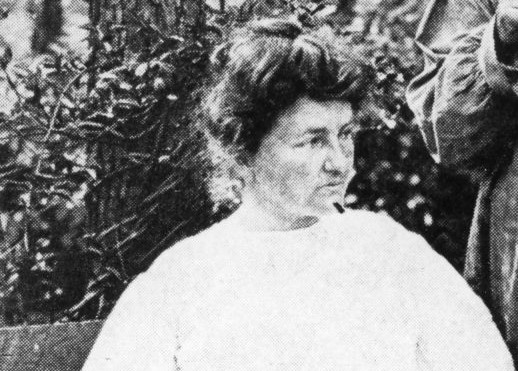Anne Higginson Spicer (died 1935)
Posted on April 23, 2024 by Jenny ONeill

WOMEN OF WESTPORT POINT
Anne Higginson Spicer (died 1935)
8 Cape Bial Lane, Westport Point
Poet, gardener, furniture maker, wood carver, artist
Westport Point became the summer retreat for a number of Chicago-based educators and artists who were active in the late 19th century Arts and Crafts movement (centered at Hull House). Westport’s environment was a source of inspiration and rejuvenation for these families. Living in Kenilworth IL, she and her husband Vibe founded the local Arts and Craft Guild and worked in pottery, copper, brass, and wood. A memorial to Anne Spicer created in 1938 featured a garden sculpture by Ruth Sherwood.
Anne Higginson Spicer and her husband Vibe followed their friends, the Yeomans, to Westport Point. Anne was a creative writer, adopting the pen name of Anchusa (a flowering plant). She published her poetry in two volumes and she was a contributor to a popular column in the Chicago Tribune called, “A Line ‘O Type or Two.”
During the summers, they settled in a little house on Cape Bial Lane “that looked out upon a thick matted slope of wild roses, bayberry, sweet fern….down to the marshes bordering the river” (Edward Yeomans). Their summers were spent at Westport Point among a group of like-minded educators and artists, enjoying music, painting, writing, sailing, gardening, and folk dancing.
She wrote several books of verse: “A Crookshire Lad” and “Songs of Skokie.”
According to a report in the Fall River Daily Herald, she became one of the most widely known women of the wood carving fraternity (or should that be sorority?) showcasing her work at the Chicago Fair in 1898.
“Being unable to find in the open market the kind of furniture which she desired, she courageously determined to learn how to make it. A most notable piece being a wood box, the front of which is covered by a design symbolic of the fire god, enriched by fire etching.”
She made a piano bench, library table, settee and chairs.
“At least one woman has been able to make furniture of an artistic quality not obtainable in the ordinary channels of trade.” (Fall River Daily Herald 1898)
Anne Spicer wrote a lengthy article for The House Beautiful, 1903. Titled
HOW TO FURNISH A HOUSE, she offers her personal views on creating an interior space:
“As the American race is a mixed type, so the American home may combine the attributes, but let them be the best ones, of all the countries of the world. The cleanliness and homeliness (in its real sense) of the English; the stability of the German, tempered by the grace of the French; and the rich coloring and comfort of the Orientals, without their dirt—all these qualities we have to draw from and make to serve us.”
Carpe Diem
(Anne Spicer, Artists in Living, 1941)
If this were my last day I’m almost sure
I’d spend it working in my garden. I
Would dig about my little plants, and try
To make them happy, so they would endure
Long after me. Then I would hide secure
Where my green arbor shades me from the sky,
And watch how bird and bee and butterfly
Come hovering to every flowery lure.
Then as I rested, perhaps a friend or two,
Lovers of flowers would come, and we would walk
About my little garden paths, and talk
Of peaceful times when all the world seemed true.
This may be my last day, for all I know;
What a temptation just to spend it so!
The House Beautiful 1903
HOW TO FURNISH A HOUSE
THERE are as many ways to furnish a house as there are families in the world—and more—for it is a poor family that cannot boast at least two conflicting ideas on furnishing among its members. Perhaps it is these conflicting ideas, at the outset which will account for the number of inharmonious, unhomelike aspects in houses about us.
The masculine and feminine ideas are vastly at variance. A man’s notion may be summed up in five words, ‘Let us be comfortable.” A woman’s idea generally is, “Let us make the house pretty.” Between these two lies the happy mean of success. If we cannot achieve this mean at the start, let us take the man’s ideal as the basis of our decorative efforts, and be comfortable first and artistic after wards. I believe we will find that comfort and beauty, if not identical, are at least twin sisters. A chair does not any longer need to be made of faded upholstery, worn to the verge of decrepitude, to embody a man’s notion of ease. Bachelors’ houses are generally well furnished. I imagine that one of the first things man would do, if given carte blanche in the average house, would be to throw most of the so-called articles of bigotry and virtu in it away. Men loathe little things, put around on tables and stands where they are easily knocked over. Men are not early trained to constraint in their movements, the way women are neither have men a love for delicate trifles. Nowhere is this difference shown strongly than in a man’s and a woman’s dressing-table. The woman’s will be littered with a myriad of tiny trifles in cut glass, and filigree—all useful, so she claims—the man’s will have a half-dozen stiff brushes and plain bottles, and that is all—unless, of course, wife, mother, or sweetheart gives him things he feels obliged to keep there.
